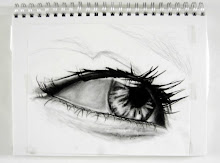1. Gessoed layer.
Gesso is a mixture of powdered chalk and animal skin glue. Panel, the support that most Renaissance artists used, be it in
the North or South, required multiple layers of gesso (usually 30-40 coats) and would be applied over a thin layer of size (cooked animal glue and water) to bind it to the wooden surface. After layers were applied, they would be sanded to a smooth, porcelain-like texture. Canvas required approximately one to two layers of gesso to accomodate its flexibility.
2. Cartoon and Under-drawing
Next, a to-scale drawn copy of the painting's composition (the cartoon) would be transfered to the gessoed panel. Holes would be pricked in along all contours of the cartoon's details, the cartoon would then be laid over the panel and powdered paint would be dusted over it, transferring the image to the panel, almost like a stencil. What kind of powdered paint depended on where the painting was being done, the North favoured charcoal, in the south sinopia. A brush dipped in oil (probably walnut) would be run over the dots of paint that transferred through the cartoon, creating the under-drawing.
For some excellent examples of Renaissance under-drawing visit Guardian.co.uk
3. Underpainting
With the underdrawing complete, the artist would then begin the underpainting. The underpainting was in either charcoal and white, or in sinopia and white. Being the detailed composition of the painting without colour, it stood as the base onto which the colour would be added. Below. an example of Leonardo's uncompleted "Adoration of the Magi" shows the artist's extensive underpainting in process of development. The artist would be very careful not to mix the white with the their dark colour; each tonal hue was to be applied separately to ensure the optimum luminosity associated with fine oil-painting.
4. Laying of Colour
Finally, after the underpainting was complete and dry, thin layers of colour would be applied over it creating the paintings we all know so well today. (ki)






No comments:
Post a Comment